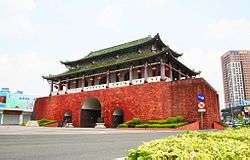Guancheng Subdistrict
| Guancheng 莞城街道 | |
|---|---|
| Subdistrict | |
|
Ying'en Gate in Guancheng Subdistrict | |
| Country | China |
| Province | Guangdong |
| Prefecture | Dongguan |
| Area | |
| • Total | 13.5 km2 (5.2 sq mi) |
| Population (2013 census:[1]) | 165,800 |
| GDP | |
| • Total | ¥ 7.358 billion (2015 Data)[2] |
| Time zone | China Standard (UTC+8) |
| Website |
文化莞城 guancheng |

Guancheng Subdistrict (Chinese:莞城街道; pinyin: Guǎnchéng Jiēdào) is a subdistrict in Guangdong Province, China under the administration of Dongguan City. It has an area of 13.5 square kilometres and a residential population of 230,000, of which 152,000 are new residents. Guancheng was the old political and cultural centre of Dongguan, before the government moved to the new centre in the Nancheng Subdistrict.[3]
Basic Information
| Item | Simplified Chinese | Content |
|---|---|---|
| Chinese Name | 中文名称 | 莞城街道 |
| English Name | 外文名称 | Guancheng Subdistrict |
| Type of Administrative division | 行政区类别 | Subdistrict |
| City | 所属地区 | Dongguan City |
| Subnational | 下属地区 | Dongzheng,Shiqiao,Xingtang Community etc. |
| Address of Government | 政府驻地 | No.1, Gaodi Street, Shiqiao Community,Guancheng Subdistrict, Dongguan City |
| Area Code | 电话区号 | 0769 |
| Postal Code | 邮政区码 | 523001-523008 |
| Location | 地理位置 | Central North of Dongguan City |
| Area | 面积 | 13.5 square kilometer |
| Population | 人口 | 26,000,000 |
| Dialect | 方言 | Cantonese-Guancheng Dialect |
| Climate | 气候 | Subtropics monsoon climate |
| License Plate Codes | 车牌代码 | Yue S(粤S) |
Introduction

Guancheng Subdistrict in Dongguan City has a history of some 1700 years, stretching back to 757 AD in the Tang Dynasty. Many culture relics remain. There is the Ke Yuan(可园), the most famous Chinese garden in Guangdong; The gate tower, Ying'en Men(迎恩门), which was built in the Ming Dynasty, has a history of more than 600 years. The Quejin Stele(却金碑) is a good scenic spot in Dongguan City, which bears testament to the Chinese people's sense of justice and probity when they had trade relations with Thailand in Ming Dynasty.
Guancheng Subdistrict gathers talented people, fortune and information together. It's a subdistrict connected with both traditional and modern trade, which provides a stage for the secondary industry. It is located on the Midwest of Dongguan City and the northeast of the Pearl River Delta. It's necessary to come and go from Guangdong and Hong Kong.[4]
Members of Leaders
Guancheng Subdistrict used to be the political center of Dongguan City. Here is the list of the politics of Guancheng Sbudistrict[5]
| Name | Position | Division of Work |
|---|---|---|
| Liu Linhong(刘林宏) | Party secretary, Director of the Liaison Committee of the NPC | All of the work |
| Chen Huizhen(陈慧贞) | Vice party secretary, Director of the Office | Responsible for the economic work |
| Zhang Ruijun(张锐均) | Vice party secretary | In charge of political science and law, social security and social stability |
| Ma Xiaoqi(马小其) | Member of the Party Committee, Secretary of Commission for DIscipline Inspecition | In charge of discipline and supervision, auditing work |
| Wu Zhi'en(吴志恩) | Member of the Party Committee, NPC deputy director of the Liaison Committee | In charge of construction of the party, organization, personnel, Office of the NPC |
| Ye Haodian(叶浩钿) | Member of the Party Committee | Adjunct director of the Public Security Bureau |
| Zhang Junhua(张俊华) | Member of the Party Committee | In charge of business circulation and urban construction |
| Peng Lei(彭 雷) | Member of the Party Committee | In charge of health and family planning |
| Zhang Kaiqiang(张凯强) | Member of the Party Committee | In charge of finance, banking and asset management |
| Ye Xiaomin(叶小敏) | Member of the Party Committee | In charge of community work,social affairs and be responsible for daily work and Social Work Committee |
| Li Hangxu(李航旭) | Member of the Party Committee | In charge of safety production, trade, science and technology |
| Chen Yudong(陈玉东) | Member of the Party Committee | Served as armed forces minister, in charge of environmental protection work |
| Liang Feng(梁 丰) | Deputy Director of the Office | In charge of urban management, utilities, and three defenses and agricultural work |
| Yu Haihua(余海花) | Deputy Director of the Office | In charge of education and the work of the Women's Federation |
| Chen Haorong(陈浩荣) | Deputy Director of the Office | In charge of the construction of spiritual civilization, publicity, culture, sports and tourism |
| Kuang Hanqiang(邝汉强) | Deputy Director of the Office | In charge of private enterprises, Chamber of Commerce and the Food and Drug Supervision and Management Bureau |
| Yan Zheng(严 正) | Deputy Director of the Office | In charge of Party and government office, planning project and urban planning work |
| Chen Jinrong(陈金荣) | NPC deputy director of the liaison Committee | In charge of poverty alleviation and trade union work |
Infrastructure
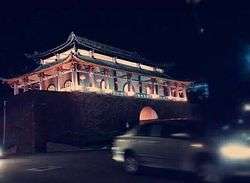
CBD
Guancheng Subdistrict forces to develop its business. There are 3 important CBD:
- West Gate Avenue (Chinese:西城门大街)
- Diwang Square (Chinese:地王广场)
- Yujing Square CBD (Chinese:愉景广场商圈)
Medical and Health

Guancheng Subdistrict is the center of medical and health in the whole city.There are many large integrated medical institutions, such as:
- Dongguan People's Hospital (Chinese:东莞市人民医院)
- Dongguan Traditional Chinese Medical Hospital (Chinese:东莞市中医院)
- Dongguan People's Hospital of Guancheng Subdistrict (Chinese:莞城人民医院)
- Guancheng Hospital(Chinese:莞城医院)
- Dongguan Maria's Maternity Hospital(Chinese:东莞玛利亚妇产医院)

Education
Guancheng Subdistrict locates in the center of downtown, which is an educational, political and economic area. It has long history of cultural deposits. This is the most outstanding advantage of education. There are a university, 3 senior high schools, 3 technical secondary schools, 8 primary schools and 19 kindergartens. Among these different kinds of schools, there is the best senior high school with hundreds years. Also, the only one university with high level science and engineering university locates in Guancheng Subdistrict.[6]
Here are some famous schools in Guancheng Subdistrict:
- Dongguan University Of Technology (Simply called: DGUT; Chinese:东莞理工学院)
- Dongguan Middle School (Chinese:东莞中学)
- Dongguan Experimental High School (Chinese:东莞实验中学)
- Dongguan Middle School—Junior High School (Chinese:东莞中学初中部)
- Dongguan Keyuan High School (Chinese:东莞市可园中学)
- Dongguan Bubugao Primary School (Chinese:东莞市步步高小学)
- Guancheng Construction of Primary School (Chinese:莞城建设小学)
- Guancheng Experimental Primary School (Chinese:莞城实验小学)
Cultural Relic
- Ke Yuan (可园)
- Quejin Stele (却金碑)
This stele locates in Guangming Road outside the North Gate of Guancheng Subdistrict. It was established from 1541, Ming Dynasty Jiajing 21 Years. It is well-preserved. Quejin Stele recorded Li Kai, the Yin(县尹) of Panyu County(番禺县), dealings with the businessmen from Siam(Thailand now) without any payment during Ming Jiajing. This stele was made from bluestone and it was hard texture. The stele is 143 cm long, 30 cm wide and 20 cm high with a red sandstone tectangular base.[7]
- Ouge Arbours (讴歌亭)
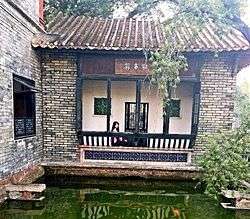
Ouge Arbours lies in west site of Yu Mountain in Dongguan People's Park. It was established from 1921. The arbours sitting southeast to northwest. It's 7.7 m wide, 6.5 m deep and 7.8 m high. Ouge Arbours was in honour of Huang Chunlin, the head of Dongguan County. He did so many good things for the local people that people built this arbours to mark what he did. In 2008, the managers of the park repaired the arbours according to its original sample and set some stone tables and stools for the tourists.[8]
- Daosheng Park (道生园)
Daosheng Park was built by Zhang Jiamo, who was the nephew of Zhang Jingxiu, the founder of Ke Yuan. It stands in Daofu Alley of Guancheng Subdistrict. The whole park sat northwest towards the southeast. Ju Chao(居巢) and Ju Lian(居廉), who were the originators of Ling-nan School of painters, have lived in this park for about 10 years. Daosheng Park became the place of origin of Ling-nan School of painters because of their living. The original area of Daosheng Park was about 750 kilometers. However, after hundreds of years, there was only several old houses, old and shabby.
Gallery
Guancheng Subdistrict is the Old Town of Dongguan City. Here are some beautiful sitghts of Guancheng Subdistrict:
-

Zhenhua Road 振华路
-

Old Business Street 莞城旧式商业街
-

Traditional Snacks in Dongguan 东莞传统小吃
-

Arcades in Guancheng Subdistrict 莞城骑楼
-
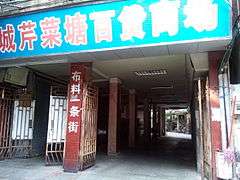
Qincai Tang Commercial Market 莞城芹菜塘商贸市场
-

Zhiting Street 旨亭街(旨亭街排骨饭)
-
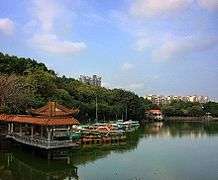
Dongguan People's Park 东莞人民公园
References
- ↑ "莞城街道人口普查 Population: How Many People Live In Guancheng Subdistrict / 东莞市莞城区". Retrieved 23 December 2015.
- ↑ "东莞32镇区最新GDP排行榜 The Latest GDP Ranking of 32 Townships in Dongguan (2015) / 东莞市莞城区". Retrieved 12 August 2015.
- ↑ 莞城街道简介 Introduction of Guancheng Substrict Retrieved December 2, 2015
- ↑ 莞城概览 Brief Summary of Guancheng Substrict Retrieved December 2, 2015
- ↑ 莞城街道领导班子 The List of Politics of Guancheng Subdistrict Retrieved December 22, 2015
- ↑ 莞城教育概览 List of Schools in Guancheng Subdistrict Retrieved December 16, 2015
- ↑ 却金碑简介—莞城古迹 Introduction of Quejin Stele Retrieved January 7, 2016
- ↑ 讴歌亭简介—莞城古迹 Introduction of Ouge Arbours Retrieved January 7, 2016
External links
- Ying'en Gate(迎恩门) This is a Chinese Website of introduction about Ying'en Men
- Dongguan Middle School(东莞中学) This is the Campus Network
- Ouge Arbours (讴歌亭) Likin Storm(厘金风波)——The Story of Ouge Arbours
- Ju Chao(居巢) This is the official website of painter Ju Chao.
- Ju Lian(居廉) This is the official website of painter Ju Lian.
- 东莞地图 This is a map of Dongguan City.
 |
Gaobu Town(高埗镇) | Gaobu Town(高埗镇) | Shilong Town(石龙镇) |  |
| Wanjiang Subdistrict(万江区) | |
Dongcheng Subdistrict(东城区) | ||
| ||||
| | ||||
| Nancheng Subdistrict(南城区) | Nancheng Subdistrict(南城区) | Dongcheng Subdistrict(东城区) |
